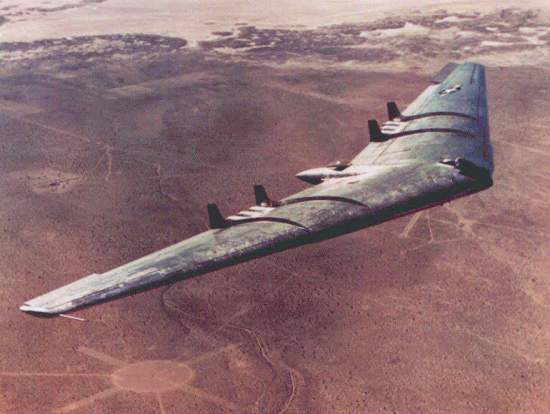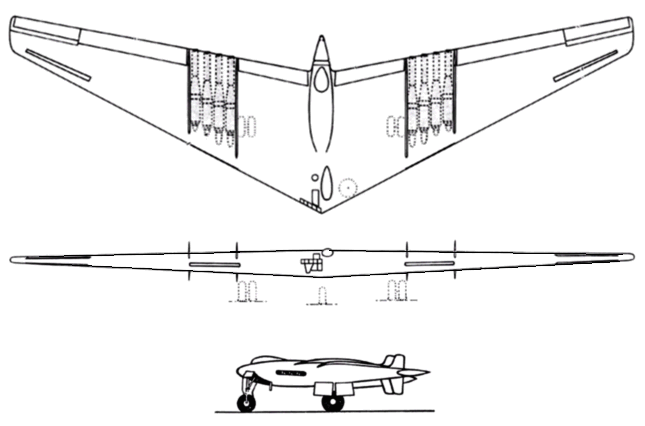|
||||||||||
|
|
||||||||||
|
||||||||||
|
|
||||||||||
 - -
|
|

|
Northrop YB-49, YRB-49 Strategic Bomber Prototype Reconnaissance Prototype |
|
DESCRIPTION:
Jack Northrop was a long-time believer in the potential of tailless aircraft and flying wings who had begun experimenting with such craft during the late 1920s. His most successful design emerged during World War II as the XB-35 long-range bomber that competed for a production contract with the B-36 Peacemaker. Although the XB-35 possessed significant payload capacity, tremendous range, and was found to be an adequately stable bombing platform, the company knew the arrival of the jet engine signalled the end of the aircraft's chances of going into production. Northrop then requested additional funds to equip two of the XB-35 prototypes with jet engines. This conversion was accomplished by replacing the four piston-powered pusher props of the XB-35 with eight Allison turbojet engines. Other modifications included the addition of four vertical stabilizers along the trailing edge and "air dams," or wing fences, extending ahead of the stabilizers to minimize cross-flow along the swept wing. The conversion process took two years, and the first jet-powered YB-49 made its first flight in 1947. Although the jet engines increased maximum speed by some 100 mph (160 km/h) and eliminated vibration troubles experienced with the piston engines, the poor fuel efficiency of the early jets reduced both range and payload. The flying wing also displayed stability problems that could not be corrected with technology available at the time, but the design's marginal stability was generally deemed sufficient for accurate bombing. Nonetheless, the project suffered a staggering setback when the second prototype crashed following an in-flight structural failure that killed all aboard. Among the victims of the fatal accident was co-pilot Capt. Glen Edwards for whom Edwards Air Force Base was later named. The first prototype also suffered an untimely end when, during high-speed taxi tests, a violent instability developed in the nose gear causing it to collapse and breaking the plane in two. However, the most damaging blow to the future of the B-49 program came when a report blasted the plane's yaw and pitch stability during bombing runs. It was also later discovered that turbulence around the bomb bay induced oscillations on dropped ordnance that resulted in large targeting errors. Thanks to this myriad of problems and the realization that the B-49 offered few advantages over the more conventional B-47 and B-52, the YB-49 was cancelled in 1949. The last hope for Northrop came when the Air Force expressed interest in developing a reconnaissance version of the YB-49. Though the small radar cross-section of the flying wing had been noticed during flight tests, it was the design's long range and high cruising altitude that most attracted the Air Force's interest. Northrop was then contracted to convert another of the XB-35 airframes into the YRB-49 spy plane prototype. Though most of the modifications made were similar to those applied to the earlier YB-49, the new aircraft was fitted with only six turbojet engines. Four of these powerplants were mounted in the trailing edge with another two placed in underwing pods near the leading edge. The relocation of these two engines allowed fuel capacity to be increased while the pylons themselves provided greater vertical surface area to improve yaw stability. Although 30 RB-49s were originally ordered, the demise of the B-49 led to the cancellation of the contract before the first YRB-49 had even flown. After completing thirteen flight tests, the single YRB-49 was put into storage and later scrapped. The Air Force also ordered all remaining XB-35s destroyed leaving none of the remarkable flying wings to survive. However, Jack Northrop's vision was finally realized in the 1980s when the Air Force unveiled the B-2 stealth bomber. While the early flying wings suffered from numerous stability problems, the B-2 employs advanced fly-by-wire control systems that make the flying wing exceptionally stable.
Last modified 29 August 2010
|
|
| HISTORY: | |
| First Flight | 21 October 1947 |
|
Service Entry
|
did not enter service
|
| CREW: |
(YB-49) six: pilot, co-pilot, flight engineer, radio operator, bombardier, gunner plus provision for a relief crew and two additional gunners planned for the production model (YRB-49) six: pilot, co-pilot, flight engineer, radio operator, photo navigator, radar navigator |
|
ESTIMATED COST:
|
unknown
|
| AIRFOIL SECTIONS: | |
| Wing Root | NACA 65-019 |
|
Wing Tip
|
NACA 65-018
|
| DIMENSIONS: | |
| Length | 53.08 ft (16.18 m) |
| Wingspan | 172.00 ft (52.43 m) |
| Height |
(YB-49) 15.17 ft (4.63 m) (YRB-49) 20.08 ft (6.12 m) |
| Wing Area | 4,000 ft² (371.5 m²) |
|
Canard Area
|
not applicable
|
| WEIGHTS: | |
| Empty | 88,100 lb (40,000 kg) |
| Normal Takeoff |
(YB-49) 194,000 lb (88,000 kg) (YRB-49) 175,000 lb (79,365 kg) |
| Max Takeoff |
(YB-49) 213,500 lb (96,840 kg) (YRB-49) 206,000 lb (93,440 kg) |
| Fuel Capacity |
internal: unknown external: unknown |
|
Max Payload
|
16,000 lb (7,255 kg)
|
| PROPULSION: | |
| Powerplant |
(YB-49) eight Allison J35-A-5 turbojets (YRB-49) six Allison J35-A-19 turbojets |
| Thrust |
(YB-49) 32,000 lb (142.35 kN) (YRB-49) 30,000 lb (133.45 kN) |
| PERFORMANCE: | |
| Max Level Speed |
at altitude: (YB-49) 495 mph (795 km/h) (YRB-49) 440 mph (710 km/h) at sea level: unknown cruise speed: (YB-49) 420 mph (675 km/h) (YRB-49) 390 mph (630 km/h) |
| Initial Climb Rate | unknown |
| Service Ceiling |
(YB-49) 40,700 ft (12,415 m) (YRB-49) 42,600 ft (12,995 m) |
| Range |
(YB-49) 2,740 nm (5,080 km) (YRB-49) 2,280 nm (4,225 km) |
| g-Limits |
unknown
|
| ARMAMENT: | |
| Gun | two electrically-operated four-gun tail turrets and four electrically-operated, remotely-controlled, two-gun turrets |
| Stations | one internal weapons bay |
| Air-to-Air Missile | none |
| Air-to-Surface Missile | none |
| Bomb |
(YB-49) various free-fall conventional or nuclear bombs (YRB-49) six T-89 photoflash bombs |
| Other |
none
|
| KNOWN VARIANTS: | |
| XB-49 | Possibly the original designation for the first YB-49, this designation is referred to in some early Northrop literature but is not believed to ever have been used by the US Air Force |
| YB-49 | XB-35 bomber prototypes that had the original powerplant of four piston engines replaced by eight turbojets and were also modified by the addition of four rudders and fences along the swept wings, the second aircraft crashed in 1948 and the first was destroyed when the nose gear collapsed during taxi tests in 1950; 2 converted |
| YRB-49 |
XB-35 bomber prototype that was rebuilt as a long-range reconnaissance aircraft prototype with four jet
engines along the wing trailing edge and two mounted in pylons near the leading edge, also equipped with
camera equipment and a radar navigation system in the center and aft fuselage, completed 13 test flights
before being put into storage and later scrapped; 1 converted
|
|
KNOWN OPERATORS:
|
United States (US Air Force)
|
|
3-VIEW SCHEMATIC:

|
|
SOURCES:
|
|


|
Aircraft | Design | Ask Us | Shop | Search |

|
|
| About Us | Contact Us | Copyright © 1997-2023 | |||
|
|
|||